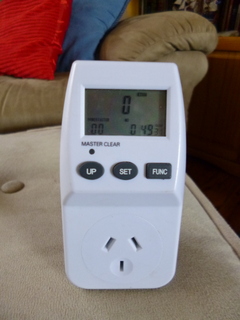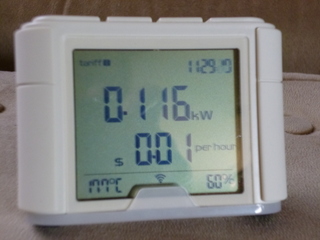A bit over a quarter of Australia’s net energy usage is by families, and those families can spend 25% or more of their income to provide the energy that fuels their lifestyle, which is a fair old whack to the hip pocket! There is also the environmental cost of greenhouse gas emissions associated with generation, transmission and consumption of energy to be taken into account. In any case it seems worthwhile to me to know where your energy dollars are going and how that expenditure can be reduced. As the quality guru, Edwards Demming once said “what you don’t measure, you don’t control” so that is where the idea of an energy audit or review comes in, to help you get a handle on and control those costs.
I suppose the first thing we need to talk about when we talk about a home energy audit, is what type of energy is it we intend to audit, because a household can consume energy (and generate greenhouse gases) directly or indirectly, a number of different ways. Energy is consumed directly by a household every time anyone turns on a power switch, but there is also an energy cost (called “embodied energy”) in the products that we purchase. For the purposes of this article we will only be talking about direct energy use.
Also, while there are a number of different types of energy that a household can consume – electricity, town gas, LPG, wood, petrol, diesel etc. in this article will only be concentrating on electricity. I am doing this for a number of reasons –
- In general terms, households consumer greater than 50% of their energy in the form of electricity (the next closest is natural gas at around 33%).
- Electricity costs here in Aus have gone up anywhere between 60% and 80% in the last 5 years and are likely to continue rise in the future.
- Like water through a sieve, electricity can leak out of your household, costing your money for no real benefit.
So assuming you want to save money as well as saving the planet, let’s continue on and get you the information you need to make informed choices about what you do next.
Bills, Bills, Bills!
The first part of our journey consists of you confirming what the big ticket items in your energy budget are (don’t just take my word for it, I certainly wouldn’t!) and you do this by downloading a copy of the household energy audit form and then getting your bills together. Get hold of a year’s worth of bills so you can get your consumption picture for an entire year. Your usage fluctuates with the seasons and you may get an inaccurately optimistic or gloomy picture of your energy consumption depending on what quarter(s) you look at, so you need a full years’ worth of bills. If you can’t find a years’ worth of bills, a quick phone call to your energy supplier will usually get the data you want. Petrol or Diesel may be a bit more difficult but they also tend to be somewhat more independent of the time of year so monitoring your consumption for a month or three, and then extrapolating the data to 12 months should be OK.
Once you have the figures for your energy consumption, in their various units, convert them all to megajoules so you can compare apples with apples. Needless to say, the biggest number is the one you need to start working with first and It makes sense to start looking at your biggest area of consumption first, but I am still betting it will be electricity.
Electricity
The next part of the audit is designed to help you work out where all that electricity goes. Part of the deal will be looking at the power consumption of your electrical stuff, either the nominal consumption you can read of the compliance plate, paperwork that came with the appliance or off the net or as measured. The measured figure is likely to be the most accurate, our microwave oven is rated at 1000 watts but when it is running it consumes 1500 watts (I suspect due to the consumption of the light and turntable motor which might not been taken into account in the rating figure.) The power consumption is only half the story however, no matter how much power an appliance is rated to consume, the actual consumption will depend on how often it is used and how long it runs.
Our microwave oven, as previously stated, consumes 1500 watts but we would run it for only minutes a day, whereas if we leave our TV on at the wall even when it is turned off at the TV itself, it still consumes 20 watts. That 20 watt consumption translates into 130 killowatt hours over the course of a year (or just over $30 in our area) because it is on 24/7, so even a small “phantom” load can translate into real power consumption quite quickly.
Nominal Vs Measured Load
The nominal load is the number of watts that the manufacturer says an item of electrical equipment consumes. It can be recorded in the customer handbook that comes with most bits of electrical equipment these days or failing that it should be listed on the compliance plate somewhere on the appliance. If both of these information sources are unavailable a quick check on the internet or a call to the manufacturer will get you the information. Lighting is a bit trickier, and the power consumption recorded on the bulb is a good start. If, however, you run halogen down lights through a transformer, a trip into the loft can be avoided by talking to someone in a lighting store to give you and idea of what the transformer itself consumes.
The form has a whole lot of suggested loads and appliances that you might have but this part of the form is suggested only and you will need to alter it to fit your circumstances (hence it is in Word format rather than .PDF). If you have a TV in every room, the form as supplied does not cater for that. Rather than setting up the form, then taking the measurements it would probably be easier to customise the form on the run, as you take and enter your energy measurements on the form.
As you get the figures, record them on the energy audit form. If you are interested (and for me this is fascinating stuff) you can measure the consumption of your electrical bits and pieces directly, and that can be quite illuminating. It will also let you know directly how the appliances are performing in your house and if the measured figure is massively larger than the rated figure it might be prudent to check a bit deeper.
There are a number of ways of getting the numbers directly and I’ve tried two, the first one is a direct read meter (A Multifunction Power Meter MS 6115) which you plug in between the appliance and the wall socket. I found it less than optimal in a number of ways –
- While I’m no Luddite (OK maybe I am but that’s not my fault) I found it to be very complicated to use, you needed to have the book of instructions next to you all the time.
- For each appliance to be checked, having to turn it off, pull out the plug, plug it into the meter, plug the whole assembly back into the wall, then turn it all back on again was somewhat of a pain.
- Any stuff not cord connected like the hot water, air conditioner and the lights could not be read.
Then we bought an “Elite Classic” wireless electricity monitor from Efergy, it has a remote sensor that connects to the feed in from the energy supplier to your house, it requires an electrician to set it up but it reads ALL of the electrical loads in your house in one go – no plugging in and out. To find out what a particular appliance or load consumes, just turn it on and note the change in the reading – it reads in kilowatt hours. It is easy to use and can calculate your costs and carbon production over time as well.
There has had one unforseen effect for us; it has really focussed us on our electricity consumption. Before we might be lazy and leave the computer going overnight, or not turn off things like the TV, microwave or CD player at the wall, but now we look at the total number and see how far we can get it down. If the freezer hasn’t cut in, we can get our consumption overnight or when we are out down to 35-40 watts which equates to a yearly base load of 310 kWh, which is not bad! The change in behaviour has meant that our latest bill shows a drop of almost 2 kilowatt hours per day, or about 50c, a saving of $180 per year. This meter paid for itself in four months just in these savings alone.
OK, so now that you have used part one to conduct the audit, part two will help you use the information you have discovered to reduce your electricity consumption and start saving money!




